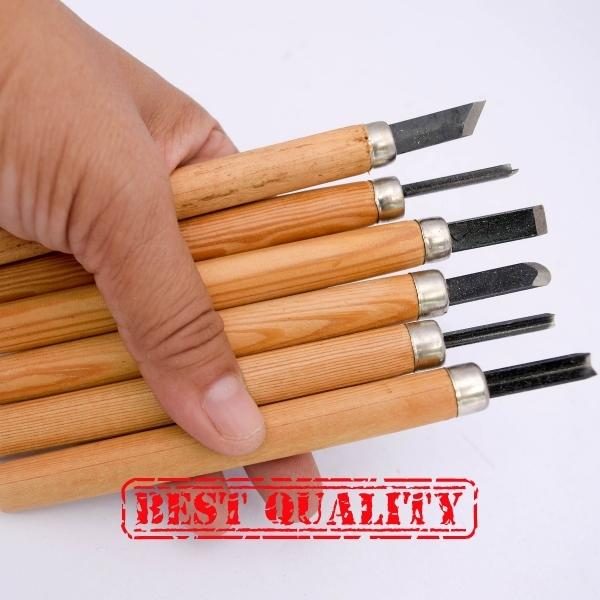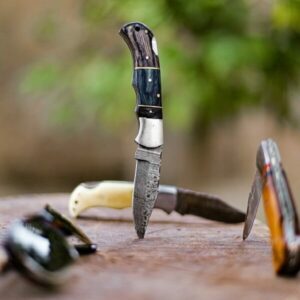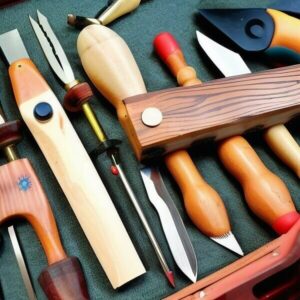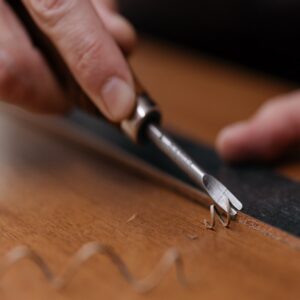Wood carving is a great hobby, but it can also be a very lucrative one. If you’re looking to get into wood carving, or you’ve been doing it for a while and would like to improve your skills, then you need to make sure that your tools are in top condition. In this guide, we will discuss how to take care of your wood carving tools so that they last longer and work better.
Keep Your Carving Tools Clean
First and foremost, you need to keep your tools clean. This means wiping them down after each use and giving them a thorough cleaning on a regular basis. You can use any number of cleaners, but we recommend using either mineral oil or WD-40. These will help to protect the metal from rust and corrosion.
Store Your Carving Tools Properly
Once you’re done cleaning your tools, you need to store them properly. This means keeping them in a dry place where they won’t be exposed to moisture or extreme temperatures. A good way to do this is to invest in a toolbox or a storage container specifically designed for wood carving tools.
Sharpen Your Carving Tools Regularly
Another important aspect of taking care of your wood carving tools is to sharpen them on a regular basis. This will ensure that they are always sharp and ready to use. There are a number of ways to sharpen your tools, but we recommend using a sharpening stone.
Use the Right Type of Oil
As we mentioned before, you need to use either mineral oil or WD-40 on your tools to protect them from rust and corrosion. However, you should avoid using any other type of oil, as this can actually damage the metal.
Don’t Use Your Tools for Other PurposesIt’s
It’s important to only use your wood carving tools for their intended purpose. Using them for anything else, such as prying or hammering, can damage the tool and potentially void any warranty that it may have.
Using Carving Power Tools
If you’re using power tools, then there are a few additional things that you need to keep in mind. First, always unplug the tool when you’re not using it. Second, make sure that the cords are not damaged in any way. Finally, never use the tool while it is wet.
Using rotary carving tools without the proper safety gear can result in serious injury.
How To Take Care Of a Carving Knife
You should sharpen your carving knife regularly to keep it in top condition. A sharp knife is not only more effective but also safer to use. You can use a honing stone or sharpening steel to sharpen your carving knife.
It is also important to clean your carving knife after each use. You should wipe the blade with a clean cloth to remove any dirt or debris. You can also use mild soap and water to clean the blade if necessary.
It is important to store your carving knife properly when not in use. You should wrap the blade in a protective sheath or cover. You should also store the knife in a safe place where it will not be damaged.
How To Maintain Wood Chisel
You should clean your wood chisel after each use. You can use a brush to remove any dirt or debris from the blade. You can also use mild soap and water to clean the chisel if necessary.
It is important to sharpen your wood chisel regularly. You can use a honing stone or sharpening steel to sharpen the chisel.
You should also oil the chisel on a regular basis. This will help to protect the metal from rust and corrosion. You can use any type of oil, but we recommend using either mineral oil or WD-40.
How To Take Care For Your Gouge
It is important to clean your gouge after each use. You can use a brush to remove any dirt or debris from the blade. You can also use mild soap and water to clean the gouge if necessary.
It is important to sharpen your gouge regularly. You can use a honing stone or sharpening steel to sharpen the gouge.
You should also oil the gouge on a regular basis. This will help to protect the metal from rust and corrosion. You can use any type of oil, but we recommend using either mineral oil or WD-40.
How Can I Protect My Carving Tools?
You should store your carving tools in a safe place when not in use. You should wrap the blade in a protective sheath or cover. You should also store the knife in a safe place where it will not be damaged.
How Can I Protect My Carving Tools When Not In Use?
One way to keep your carving tools in top condition is to protect them when not in use. You can do this by storing them in a safe place, such as a toolbox or cabinet. If you have more than one set of carving tools, you may want to consider investing in a storage system that keeps them organized and separated from each other.
How To Clean Wood Carving Tools?
The most important thing to remember when cleaning your wood carving tools is to use the right type of cleaner. You should use either mineral oil or WD-40 to clean your tools. This will help to protect the metal from rust and corrosion.
You should also avoid using any other type of cleaner, as this can actually damage the metal. If you need to use soap and water, make sure to rinse the tool completely afterward.
Finally, always dry your tools after cleaning them. This will help to prevent rust and corrosion. You can either air dry your tools or use a clean cloth to wipe them down.
How Often Should I Oil My Carving Tools?
You should oil your carving tools at least once a week. You can do this more often if you use your tools frequently or if you live in a dry climate. When you oil your tools, be sure to wipe off any excess with a clean cloth.
How Often Should I Sharpen My Carving Tools?
You should sharpen your carving tools regularly. A sharp knife is not only more effective but also safer to use. You can use a honing stone or sharpening steel to sharpen your carving tools.
Can I Use A Dremel To Sharpen My Carving Tools?
Yes, you can use a Dremel to sharpen your carving tools. However, you should only use the Dremel for light sharpening. If you need to do a more thorough sharpening, we recommend using a honing stone or sharpening steel.
Should I Oil My Carving Tools Before Or After Sharpening Them?
It doesn’t really matter whether you oil your carving tools before or after sharpening them. However, we recommend doing it after sharpening so that the oil can help to protect the newly sharpened edge.
How Do I Know When My Carving Tools Need To Be Replaced?
eventually, every carving tool will need to be replaced. You’ll know it’s time to replace your carving tools when they become dull or damaged. If you take good care of your carving tools, they should last for many years.
How Can I Tell If My Carving Tool Is Dull?
There are a few signs that your carving tool is dull. First, the tool will feel heavier than usual when you use it. Second, the tool will require more force to cut through the wood. Finally, the tool will produce shavings that are thinner than normal.
If you notice any of these signs, it’s time to sharpen or replace your carving tool.
Which Type Of Oil Should I Use On My Carving Tools?
There are plenty of oils available to use on your carving tools, however, we suggest using mineral oil or WD-40. This will help to prevent the metal from rusting and corroding. You may either apply the oil with a clean cloth or brush. Allow at least 30 minutes for the oil to seep into the metal before wiping off any excesses.
What Type Of Cleaner Should I Use On My Carving Tools?
There are a few different types of cleaners you can use on your wood carving tools. You can either use a water-based cleaner, an oil-based cleaner, or a solvent-based cleaner.
Water-based cleaners are the most gentle and will not damage your tools.
Oil-based cleaners will protect your tools from rust and corrosion but can damage the wood. Solvent-based cleaners are the strongest and will remove all dirt and grime from your tools but can also damage them. You should always test a small area of your tool before using any cleaner on the entire tool.
Can I Use Soap And Water To Clean My Carving Tools?
Yes, you can use soap and water to clean your carving tools. However, you should only use mild soap so that it does not damage the tool.
Is It Okay To Air Dry My Carving Tools After Cleaning Them?
Yes, it is okay to air dry your carving tools after cleaning them. You can also use a clean cloth to wipe them down. Avoid using a towel as this can leave behind lint or other particles that can damage the tool.
What Should I Do If My Carving Tool Is Damaged?
If your carving tool is damaged, or rusty you should either repair it or replace it. If the damage is minor, you may be able to repair it with a file or sharpening stone. However, if the damage is more severe, you will need to replace the tool.
Conclusion
Taking care of your wood carving tools is important if you want them to last. You should sharpen, oil, and clean your carving tools on a regular basis. If your carving tool is damaged, you may be able to repair it or you will need to replace it.
Keep using these tips to extend the lifespan of your wood carving tools, remember that eventually, every carving tool will need to be replaced. With proper care, your carving tools will be in top condition and should last for many years.









